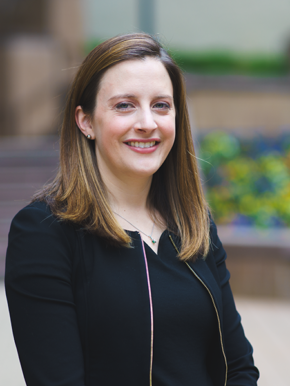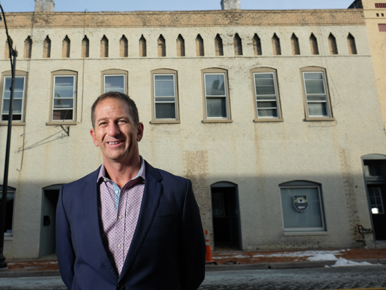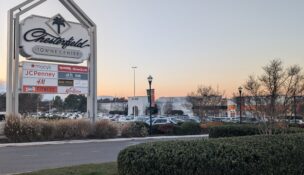The Land of OZ
Opportunity zones have financial impact, but how much?
Kate Andrews //January 31, 2020//
The Land of OZ
Opportunity zones have financial impact, but how much?
Kate Andrews //January 31, 2020//
Anybody up for pickleball? Barrett Worthington and Megan Charity hope so.
Business partners based in Charlottesville, Worthington and Charity are among Virginia’s opportunity zone pioneers. They hope to build an $8 million entertainment complex called Rally, containing a restaurant, beer garden and courts for pickleball — a mix of badminton, tennis and pingpong — in Richmond’s Manchester neighborhood.
Worthington, a University of Virginia Darden School of Business graduate, and Charity, an internationally ranked pickleball player and coach, are seeking $3.7 million in investment capital for Rally. In their quest, the partners are working with Opportunity Virginia, the state-funded online marketplace started by Virginia Community Capital and its subsidiary, LOCUS Impact Investing.
Opportunity Virginia’s mission is twofold: connecting entrepreneurs with investors via the recently launched opportunityva.org website, and educating small business and property owners about available tax benefits and how to market their ideas to investors.
Created as part of the 2017 federal Tax Cuts and Jobs Act, opportunity zones were designed to promote economic development in lower-income areas by giving investors the chance to defer and reduce capital gains taxes. Investors put their money into Qualified Opportunity Funds, investment vehicles for development projects in one of 8,700 census tracts designated by the U.S. Treasury as opportunity zones in 2018. Virginia has 212 such opportunity zones spanning the commonwealth, from rural tracts in Southern and Southwest Virginia to urban neighborhoods in Hampton Roads, Richmond and Arlington.
Over the past year and a half since the zones were approved, most of the legislation’s beneficiaries have been high-net-worth investors backing properties in communities that already have plenty of developer interest. Several bombshell stories have come out in recent months in the national press about billion-dollar luxury projects in fancy neighborhoods that were shoehorned into opportunity zones. Among the beneficiaries are former White House communications director Anthony Scaramucci and former “junk bond king” Michael Milken.
But this isn’t the whole story, promoters of opportunity zones in Virginia say. Eligible localities had a lot of input into which geographic areas were designated as opportunity zones. Several organizations are helping people in these localities market available properties with training workshops and small grants.
The state’s Department of Housing and Community Development and the Appalachian Regional Commission are working with rural counties in particular to produce marketing prospectuses.

“Real estate developers go after low-hanging fruit,” acknowledges Kristen Dahlman, a VHCD senior policy analyst who was involved in the nomination process for Virginia’s opportunity zones (frequently referred to as “OZ” for shorthand). She has continued working with Opportunity Virginia to conduct OZ workshops around the state.
As information spreads about opportunity zones, Dahlman and others hope to encourage developers and investors to take a chance on properties in less-proven markets such as Southwest Virginia coal country, Martinsville, Danville, Petersburg or Norfolk’s St. Paul’s neighborhood.
If I only had a crane
When opportunityva.org was launched last October, Opportunity Virginia Executive Director Adam Northup said he knew of about 150 OZ-located projects in the state, but as of early January, only 25 Virginia plans were listed online, seeking investors. Northup notes that participation in the site is voluntary, and developments that have secured funding have no reason to be posted there.
Although OZ investment has started slowly, Dahlman is hopeful. The benefits encourage long-term investment, she says; if the investor remains committed to a project for more than five years, they pay 10% less in taxes on income from the project. After 10 years, the investor does not have to pay any taxes on capital gains produced.
Many potential investors were waiting for the IRS to release its final regulations, which came out in late December, and others want to see how the early investments do, Dahlman says.
“I would say that the activity is only going to increase. This is a brand-new federal program.”
For Worthington and Charity, who are investing in their first business property, cost was a paramount concern. They first considered buying land in Scott’s Addition, one of Richmond’s hottest neighborhoods, where millennial-friendly craft breweries, apartments and sports entertainment venues offering golf, shuffleboard and bowling pop up almost weekly.
Quickly they realized “economically it didn’t make sense,” Worthington says. “Our concept is fairly large-scale.” Scott’s Addition simply didn’t have enough affordable land for the proposed 40,000-square-foot, two-story complex and its accompanying outdoor seating.
In Richmond’s less-developed Manchester area, which also attracts a millennial population with money to spend on leisure activities, the partners found property within a designated opportunity zone.
They connected with Opportunity Virginia and became one of the first 25 properties listed on its website, which provides details about the project and its need for $3.7 million in investment funds. Worthington says they’re close to reaching their target, and she and Charity hope to break ground this spring, with completion anticipated in 2021.
Worthington and Charity would have chosen Manchester even without its opportunity zone designation, they say, but the exposure on Opportunity Virginia’s site and the potential tax benefits have helped them find and attract investors.
Experienced developers are “more in tune with it than anyone else,” Worthington says of opportunity zone benefits. “It’s still a bit ‘Wild, Wild West’ where people are learning how it all works.”
A horse of a different color

Dain Hammond, who owns the Hammond Asset Management development company and co-owns Hammond Insurance Services, has benefited from historic tax credits to develop multiple projects in Harrisonburg, Staunton and Richmond’s Jackson Ward neighborhood.
In other words, he’s no novice.
But Hammond didn’t know how he could benefit from opportunity zones until a friend suggested looking into it.
Last year, he was about to walk away from a potential mixed-use office and residential project near Harrisonburg’s Court Square after learning that tax credits wouldn’t cover the $465,000 building cost and estimated $1.25 million in renovations. Hammond also owed taxes on $500,000 in capital gains.
“I couldn’t get the numbers to work,” he recalls. The day before he planned to cancel the contract, however, a friend mentioned that he could defer the capital gains taxes by 15% for seven years by investing in a Qualified Opportunity Fund.
Hammond likens the opportunity zone policy to the IRS’s 1031 exchange, which saves property sellers from paying heavy taxes on the income they make from a sale as long as they invest in another property within 180 days.
As a result of repositioning the Court Square area project as an opportunity zone development, he was able to move forward. He expects to renovate the building into offices on the first floor with a loft-style apartment on the second floor, featuring wrought-iron detailing and a 1930s-era storefront look.
“I think [opportunity zones are] underutilized,” Hammond says. “I’m the second project in the central [Shenandoah] Valley area. It’s a smaller crowd that can benefit from it.”
But now that Hammond is aware of the benefits, he’s shared the information with a local Rotary Club and a Realtors’ group, and he’s searching for properties in other opportunity zones.
Return to OZ legislation
The major challenge in judging the impact of opportunity zones is the total lack of reporting requirements.
Julian Hayter, an associate professor of leadership studies at the University of Richmond who has studied civil rights and urban history, says opportunity zones’ benefits for disadvantaged communities depend heavily on implementation and local awareness, particularly among small business owners.
“A lot of Washington’s good intentions fail locally because of people,” Hayter says, pointing to earlier policies such as public housing, block grants and welfare. “There are a lot of contextual factors, and if people aren’t aware of those factors and forces, it can be like throwing gasoline on the fire.”
Right now, he says, there’s not enough data to judge the impact of opportunity zones. “It’s hard to say. I wish I could be more definitive, but I can’t.”
This could change, however, with a bill introduced in December by U.S. Sen. Tim Scott, the author of the original federal opportunity zone legislation. Scott’s proposed legislation would beef up OZ reporting rules, requiring the U.S. Treasury to publicly track metrics such as the total number of Qualified Opportunity Funds, distribution of opportunity zone investments and the number of jobs created or sustained by opportunity zone investments.
As of late December, most of Scott’s co-sponsors were other Republicans, but U.S. Sen. Mark Warner, D-Virginia, also backs stronger reporting requirements.
“I believe there should be mechanisms in place to ensure transparency and prevent the risk of any fraud or abuse in the program that could steer money away from creating new jobs and expanding economic opportunity in the communities that need it the most,” Warner said in a statement.
Bobby Werhane, an assistant vice president of commercial and multifamily mortgage banking company Bellwether Enterprise who is based in Charlotte, North Carolina, has worked extensively with major clients interested in investing in opportunity zone projects nationally, and he says that reporting requirements would not likely cool investment.
Major fund managers already voluntarily subscribe to reporting measures as an industry standard, anticipating federal requirements, although they don’t necessarily track the same details that states would be interested in, like job creation, Werhane says.
He predicts that by the end of 2026 the federal government will assess the opportunity zone program, judging how much good it has done in underinvested communities, along with other metrics. If the outcome is favorable, Werhane says, the government could allow more land tracts to be designated opportunity zones, based on 2020 U.S. Census data.
Northup and Dahlman agree that more reporting requirements would be welcome in the meantime.
“The stated purpose of the OZ program is to build wealth and prosperity for residents in the opportunity zones,” Northup says, “but how will we know if this tax/social policy is meeting that goal if there is no measurement?”
o
















